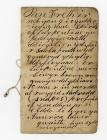Content can be downloaded for non-commercial purposes, such as for personal use or in educational resources.
For commercial purposes please contact the copyright holder directly.
Read more about the The Creative Archive Licence.
Description
Herrings were usually preserved in salt towards the end of November when the quality of the fish was at its best. The process of salting them varied a little from district to district, but basically it followed a similar pattern:
Method
- Take about a dozen fresh herrings, and split them open.
- Remove their entrails, clean them thoroughly and put them in a large earthenware dish.
- Cover them with salt, tossing and turning them in it at regular intervals for about one hour.
- When it has absorbed sufficient salt, the herring becomes pliable, so that it is possible to bend it, head to tail.
- Treat some three or four dozen herrings in this way.
- Put a thick bed of salt at the bottom of a wooden cask or tub, lay the herrings tightly, side by side and head to tail on the salt, and cover them with another layer of salt.
- Continue to arrange them in alternate layers until all the fish are well covered with salt.
- Leave for some nine days until the salt has turned to brine.
- Then lift the herrings out of the brine, wash and drain them well.
- Re-arrange the herrings in layers in a clean tub.
- Dissolve sufficient salt in boiling water so that an egg will float in it and pour this solution over the herrings, to cover them.
- Store the herrings in this ‘pickle’ and use them, when needed. (The solution should be changed periodically.)
Aberdaron, Lleyn.
The salted herrings were stored between layers of dry salt in certain districts – it would not turn to brine the second time, e.g. Aber-porth, Cardiganshire.






Do you have information to add to this item? Please leave a comment
Comments (0)
You must be logged in to leave a comment